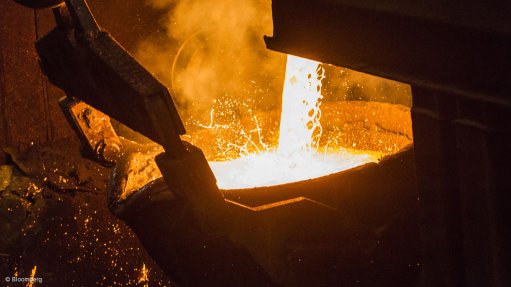
INVESTIGATION PENDING
The market and smelter investigation for the T3 project has been put on hold until production and concentrate specification is available
Photo by: Bloomberg
Investor in strategic natural resource opportunities Metal Tiger has received all sample assays from previous infill/ extensional drilling at its T3 copper/silver project, in Botswana, and is making good progress with its prefeasibility study (PFS) which is on track for completion in the fourth quarter of this year.
“With the previously outstanding drillhole assay results now being sent to the project’s resource consultant in South Africa, we anticipate being able to release an updated and enlarged T3 mineral resource estimate, incorporating the results of the infill drilling and the underlying Zone 2 mineralisation, during August,” said Metal Tiger CEO Michael McNeilly in a statement released in July.
He noted that, in addition to being an important project metric, the updated T3 resource would feed directly into the mining and geotechnical workstreams of the T3 openpit PFS, which was progressing well and should be completed around November.
Located on the Kalahari Copperbelt in northern Botswana, the T3 project is a joint venture (JV) between Aim-listed Metal Tiger (30%) and Australia-listed copper company MOD Resources (70%). Activities in Botswana are conducted under the JV’s local operating company Tshukudu Metals Botswana.
Tshukudu has received the sample assay results for the 11 outstanding drillholes at the T3 deposit, which include five new resource infill holes (MO-G-67D to MO-G-71D) and six previous holes (MO-G-52D to MO-G-59D).
Significant widths of both Zone 1 (existing resource) and underlying Zone 2 minerali- sation were intersected in all five of the new resource holes.
The six previous holes were extended to intersect Zone 2 mineralisation below the southern end of the existing T3 resource and appear to show that Zone 2 merges with Zone 1 mineralisation near the southern boundary of the resource. Extended holes MO-G-55D and MO-G-56D intersected mode- rate mineralisation, including 10 m at 0.6% copper and 12 g/t silver from 194 m down hole depth. Hole MO-G-52D was not assayed.
The intersections from the eight geotechnical holes drilled around the perimeter of the scoping study pit design were announced on June 13. These included 46.6 m at 2.1% copper and 32 g/t silver from 96 m downhole depth in hole Geotech 7.
Zone 2 remains open to the north and further holes are planned for when T3 drilling resumes (possibly in August) on the approval of the environmental management plan.
All holes were designed to intersect the northerly dipping mineralisation and are orientated with an azimuth of 160º and dip of 60º. New resource diamond drillhole MO-G-67D reached a down hole depth of 493.6 m, MO-G-68D reached 484.68 m, MO-G-69D reached 366.39 m, MO-G-70D reached 373.42 m and MO-G-71D reached 451.73 m.
Existing diamond drillhole MO-G-52D was extended to 352.67 m, MO-G-53D to 265.47 m, MO-G-54D to 274.57 m, MO-G-55D to 322.52 m, MO-G-56D to 376.51 m and MO-G-59D was extended to 322.50 m.
PFS Progress
The T3 openpit prefeasibility works are progressing according to schedule, with mining and processing studies under way with associated site visits completed.
The environmental baseline flora and fauna studies, archaeological-impact assessment and stakeholder engagement planning and policy have been completed. Digital terrain modelling and imagery is available for all consultants, while, for the process and infrastructure study, proposed preliminary site layouts have been completed.
Also under way is the mineral resource estimate update, with all drilling results and assay data in the hands of South African resource consultant Sphynx Consulting.
Further, the geotechnical study is complete, subject to the results of the updated mineral resource estimate. The mining study is also under way, where preparation work and trade-off studies have been completed in anticipation of the updated mineral resources estimate. The hydrogeological study has completed initial testing, with Phase 2 borehole selection planned for when drilling resumes. The metallurgical testwork of composite samples of the three T3 ore domains (chalcopyrite, bornite and chalcocite) are also under way, with Metal Tiger pleased by the early results.
Several project elements are in the tender stage, namely the tailings storage facility and the hydrogeological and site water modelling. Tender request for these aspects have been issued and design work is planned to start this month. The environmental-impact assessment, scope and tender process is also planned to start this month, with work set to start in September.
The market and smelter investigation has been put on hold until production and concentrate specification is available.
MOD has appointed an Australian consultant to advise on the T3 resource estimate and other mining aspects of the PFS, specifically the possibility of upgrading the resource to a potential reserve.
Following details of the airborne electro- magnetic (AEM) survey over 50 km of the T3 Dome and confirmation of the T3 anomaly announced in early July, initial interpretation of the AEM data by MOD consultants has indicated potential for multiple new targets, says Metal Tiger. Results of this interpretation are expected soon.
Project Background
T3 is parallel to the same structural trend, the Mahumo Structural Corridor, that hosts MOD’s Mahumo project, about 20 km northeast of T3, and Cupric Capital’s Banana Zone deposit (60 km north-east) and Zone 5 project (120 km north-east).
The T3 deposit was discovered in March 2016 when a reverse circulation drillhole intersected 52 m at 2% copper and 32 g/t silver from shallow depth. The maiden T3 Joint Ore Reserves Committee-compliant mineral resource was announced on September 26, 2016.
The results of a scoping study for an openpit mine at T3 with a two-million-ton-a-year processing plant, an indicative mine life of ten years and an average production rate of 21 800 t/y of copper and 665 000 oz/y of silver were released on December 6, 2016. Work on the PFS started in January this year and additional deeper copper mineralisation was discovered below the T3 resource in February.